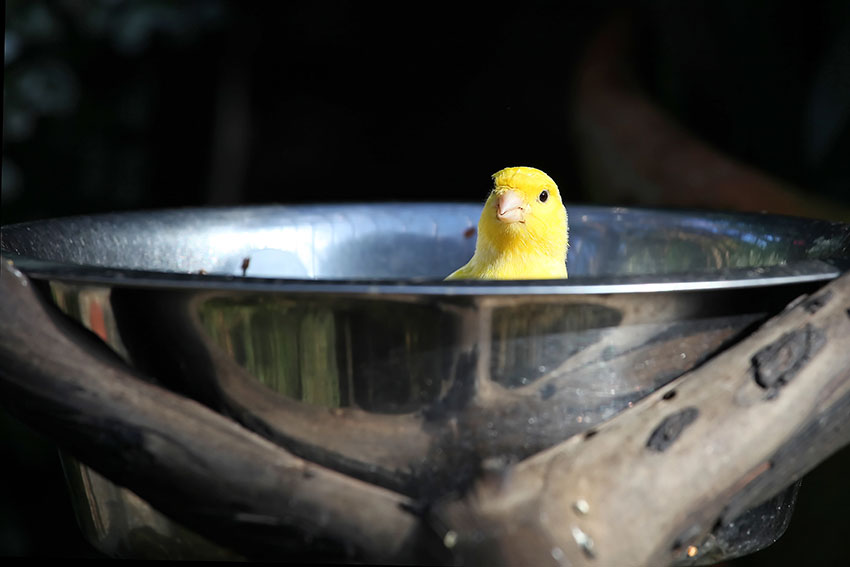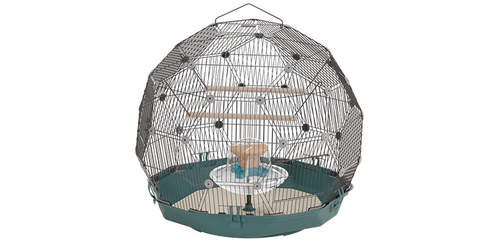Canaries and finches like to bathe regularly, so a shop-bought bath, or a simple dish of water, should be made available to them at least twice a week. Bathing clears dust from feathers, and helps the birds to cool off. They also enjoy splashing around, even if they’re not particularly dusty or hot. If there is no bird bath in the cage, pet finches may attempt to wash themselves in the drinking water - a clear message that you should provide a proper bath.

Canary enjoying a bath
There are many bird baths available in shops and online, from plastic items that clip to the sides of cages, to concrete plinths suitable for outdoor aviaries. The most practical baths for cages are the ones that clip to the open parts of the cage - the door area, or the space where the food trays sit. A non-tipping shallow tray will serve just as well, but will cause more splashing. You should also bear in mind that the bath needs to be placed in and removed from the cage with ease, so always choose a model that suits your cage set up.
Baths can also be external to the cage, if your Canary is allowed free flight in the room. A bowl of water placed on the floor is all you need, possibly on a sheet of newspaper or a towel to soak up the spillage. Always choose a bowl that will sit securely on the floor: if it tips or rocks, the Canary will panic.
Many Canaries enjoy being sprayed with lukewarm water. Once you have seen your bird happily bathing, and once he is used to you and your hands near his cage, try spraying him with a plant-mister spray. If he spreads his wings, fluffs up his feathers and shakes himself, he’s enjoying it. If he flees from the perch and flaps around the cage, he isn’t having a good time. Some birds take to it straightaway, others seem more averse to being showered.
Finch Bath Water Temperature
Birds should always be given cool or lukewarm water baths or showers. Don’t use water that has been refrigerated, and if your tap water is very cold, let it stand for 20 minutes or so before offering it as a bath.
At the other end of the acceptable heat scale, room temperature is good. The bath water must never be hot, though. If you stick with a ‘cool to tepid’ scale, you’ll be fine.





Comments
Karen, 19 March 2020
I didn't buy a specific cage. Before purchasing my birds I patiently waited for horizontal type cages to arrive at the thrift store. Then I snipped the walls between and made a 6 foot horizontal cage. I was careful to make sure everything was attached, and had no rough edges where clipped (glued on beads sometimes). I then "decorated" to suit the birds. These cages had narrow gaps. On a different cage I glued wood doweling or false greenery to block the areas. A lot of work...but it works. You have to pay attention to the design of the cage, so that getting your hand in and cleaning is possible.
Roddy, 24 April 2018
I wish I had looked on your website before embarking on Finch-keeping. So much practical advice, some of which I have learned along the way. I purchased 2 boy finches recently (because I didn't want them breeding) and put them in a cage I had purchased in France, not realising that Finches are escapologists!. The bars were too wide and one of them limbo'ed between the bars and would sit on the window ledge watching the traffic, only coming back to the cage for food, water and to sleep! He is now named Harry (after Houdini). I have since purchased a cage with narrower gaps and am now researching a flight cage for them (more room for them and preferable to flying around the front room!). Any suggestions on the best place to buy a suitable flight cage, to placed on a table, would be very much appreciated. Regards